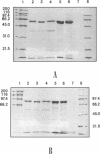Abstract
The insecticidal activity of the CryIA(a), CryIA(b), and CryIA(c) toxins from Bacillus thuringiensis subsp. kurstaki HD-1 was determined in force-feeding experiments with larvae of Choristoneura fumiferana, C. occidentalis, C. pinus, Lymantria dispar, Orgyia leucostigma, Malacosoma disstria, and Actebia fennica. The toxins were obtained from cloned protoxin genes expressed in Escherichia coli. The protoxins were activated with gut juice from Bombyx mori larvae. Biological activity of the individual gene products as well as the native HD-1 toxin was assessed as the dose which prevented 50% of the insects from producing frass within 3 days (frass failure dose [FFD50]). The three toxins were about equally active against M. disstria. In the Choristoneura species, CryIA(a) and CryIA(b) were up to fivefold more toxic than CryIA(c). In the lymantriid species, CryIA(a) and CryIA(b) were up to 100-fold more toxic than CryIA(c). The toxicity of HD-1 was similar to that of the individual CryIA(a) or CryIA(b) toxins in all of these species. None of the CryIA toxins or HD-1 exhibited and toxicity towards A. fennica. Comparison of the observed FFD50 of HD-1 with the FFD50 expected on the basis of its crystal composition suggested a possible synergistic effect of the toxins in the two lymantriid species. Our results further illustrate the diversity of activity spectra of these highly related proteins and provide a data base for studies with forest insects to elucidate the molecular basis of toxin specificity.
Full text
PDF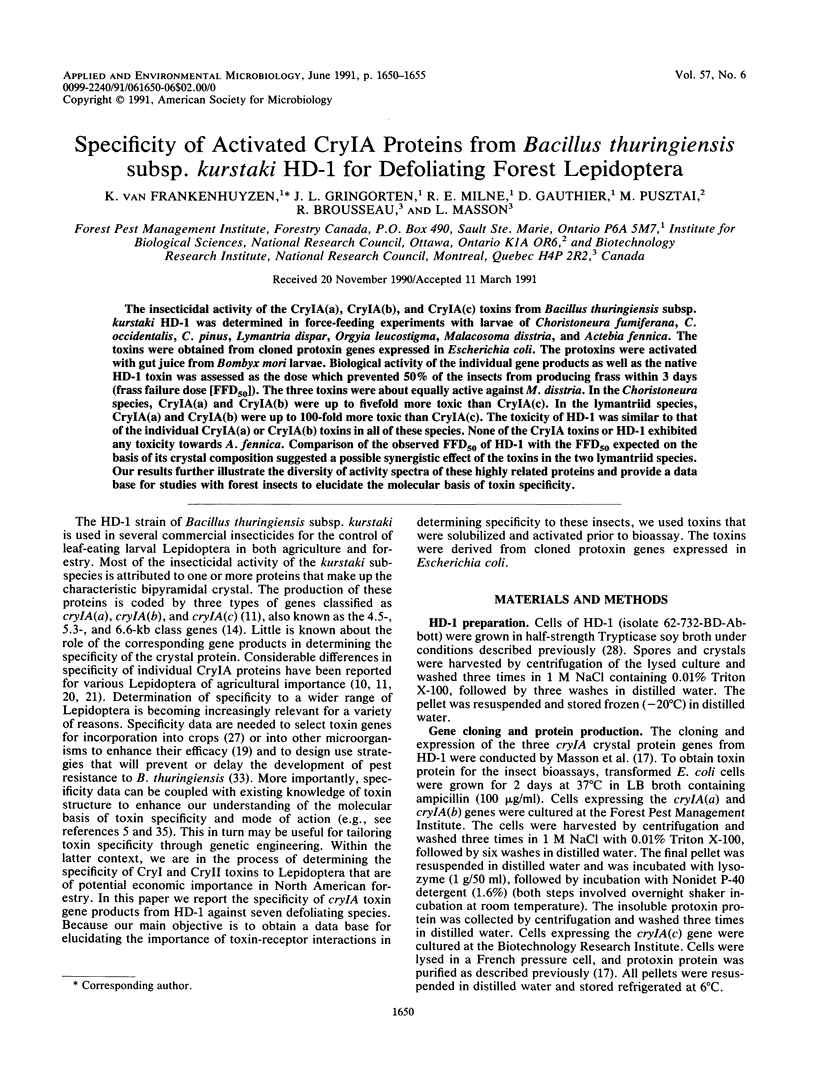
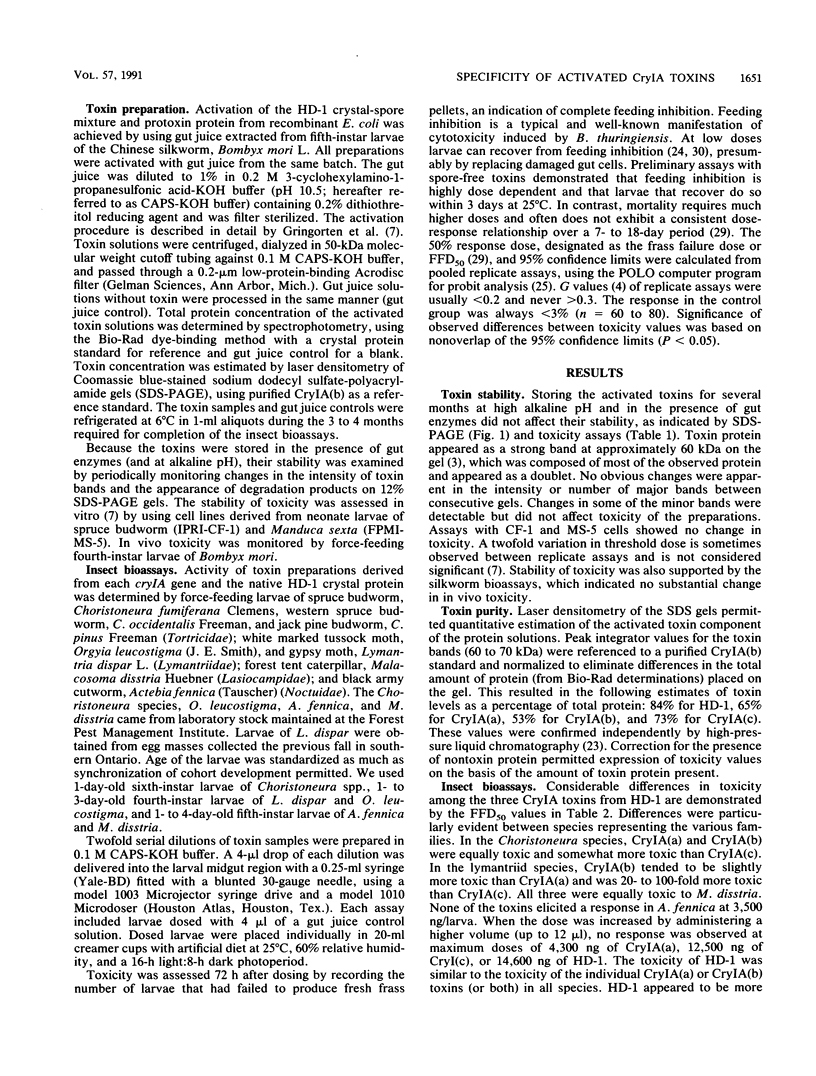
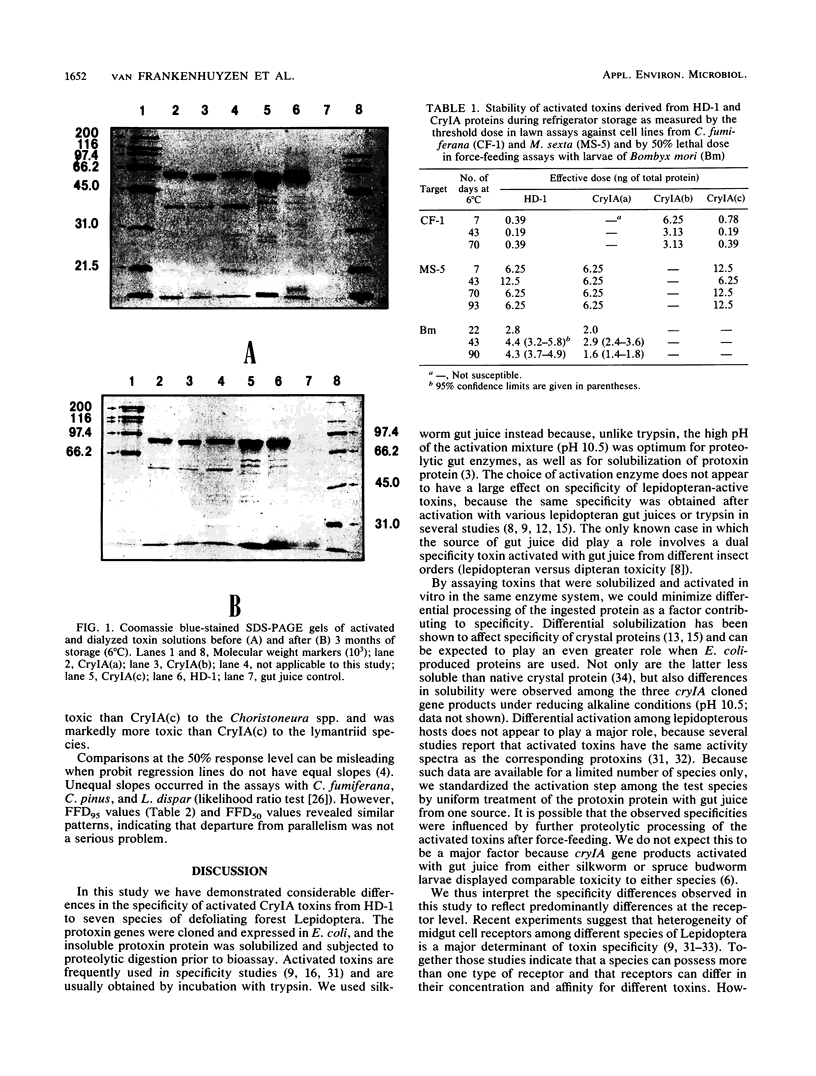
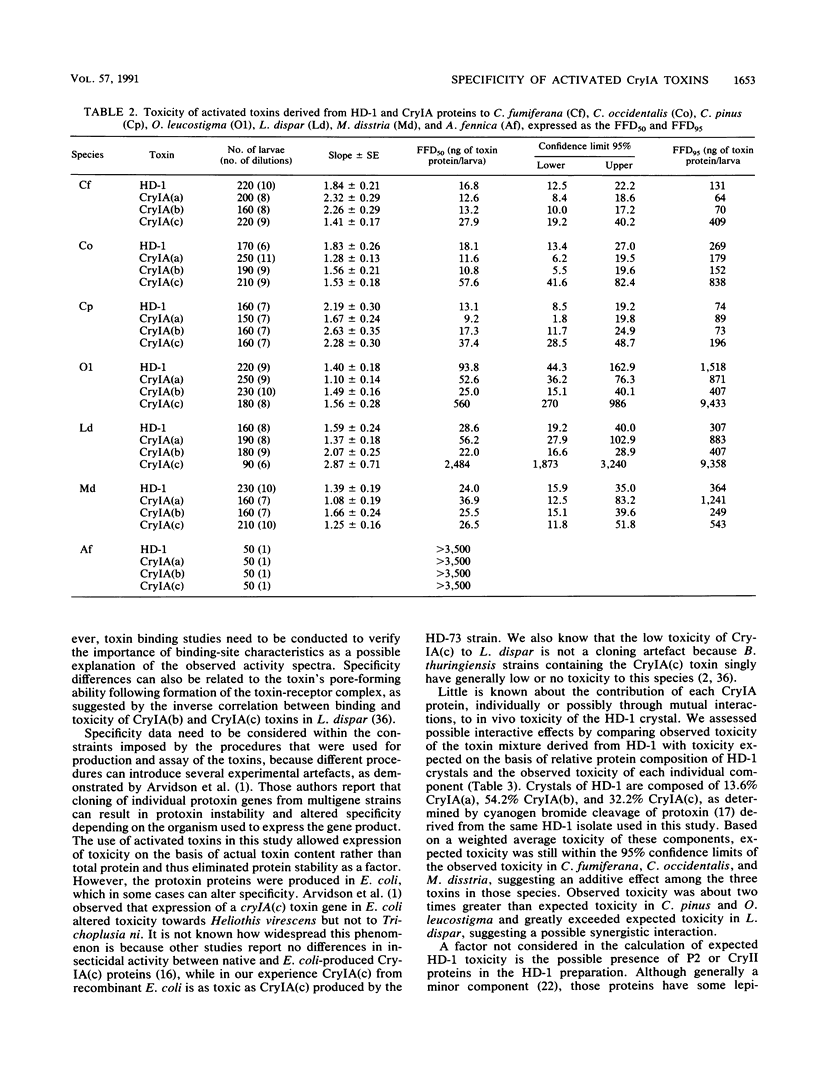
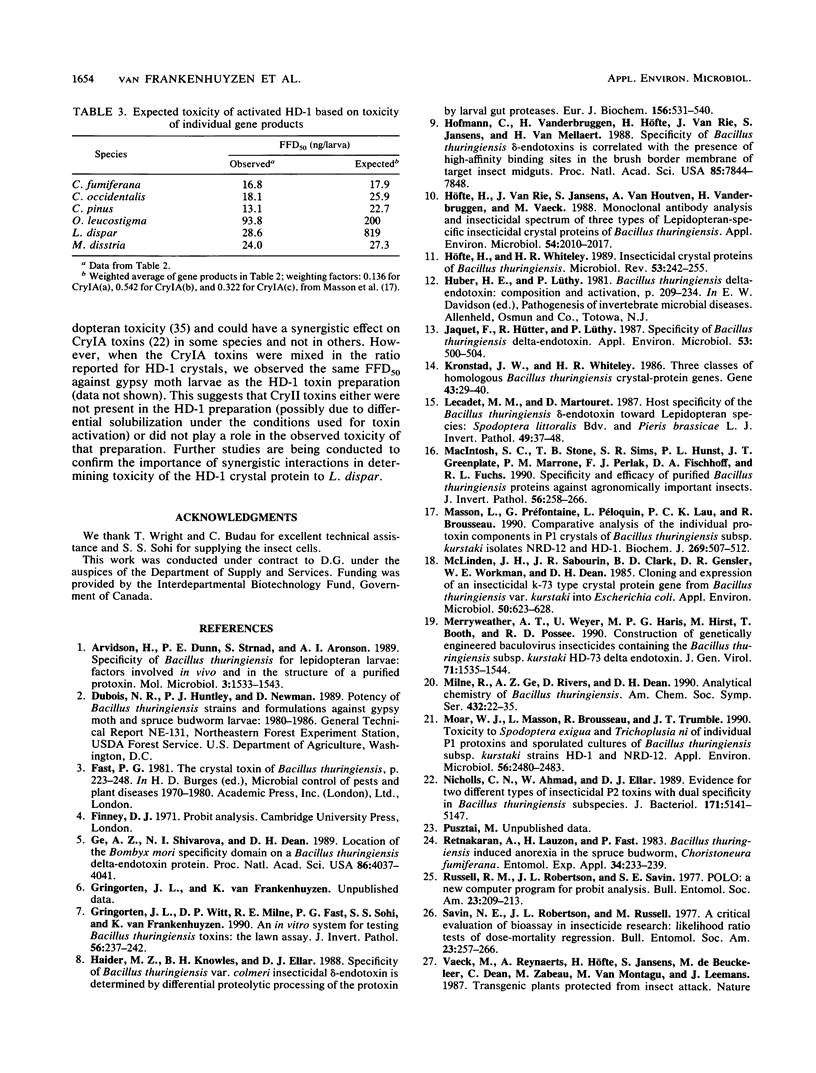
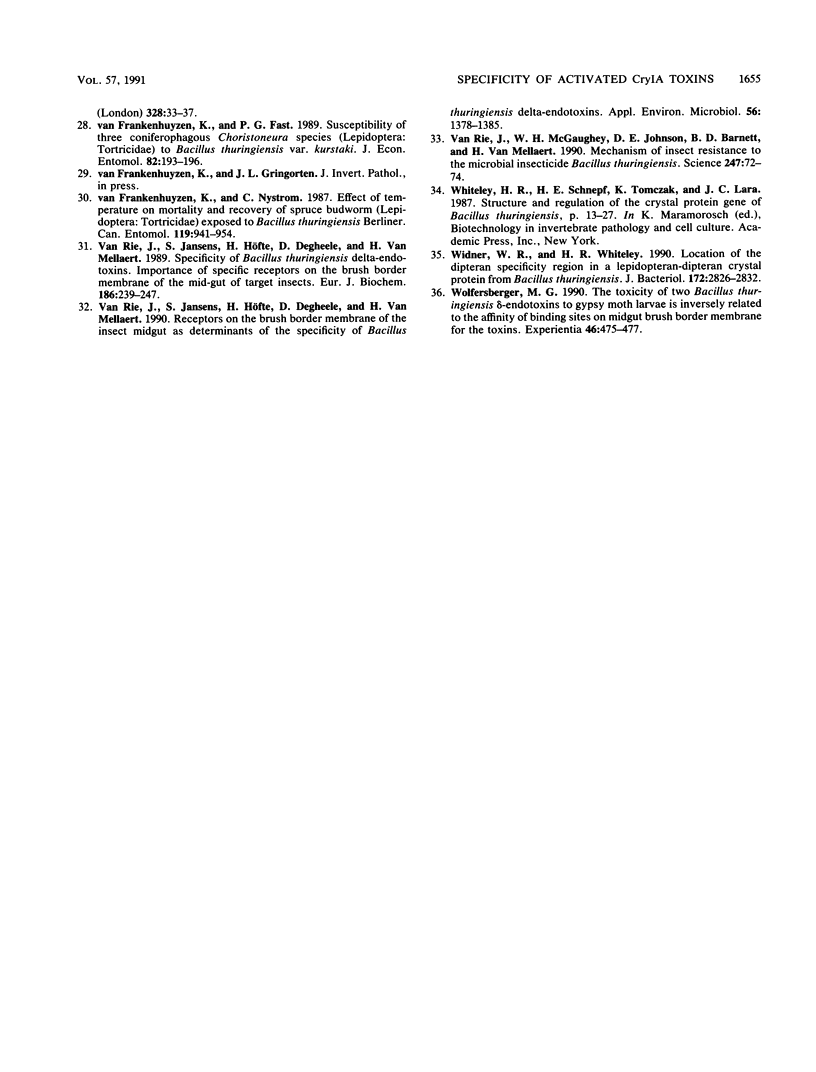
Images in this article
Selected References
These references are in PubMed. This may not be the complete list of references from this article.
- Arvidson H., Dunn P. E., Strnad S., Aronson A. I. Specificity of Bacillus thuringiensis for lepidopteran larvae: factors involved in vivo and in the structure of a purified protoxin. Mol Microbiol. 1989 Nov;3(11):1533–1543. doi: 10.1111/j.1365-2958.1989.tb00139.x. [DOI] [PubMed] [Google Scholar]
- Ge A. Z., Shivarova N. I., Dean D. H. Location of the Bombyx mori specificity domain on a Bacillus thuringiensis delta-endotoxin protein. Proc Natl Acad Sci U S A. 1989 Jun;86(11):4037–4041. doi: 10.1073/pnas.86.11.4037. [DOI] [PMC free article] [PubMed] [Google Scholar]
- Gringorten J. L., Witt D. P., Milne R. E., Fast P. G., Sohi S. S., van Frankenhuyzen K. An in vitro system for testing Bacillus thuringiensis toxins: the lawn assay. J Invertebr Pathol. 1990 Sep;56(2):237–242. doi: 10.1016/0022-2011(90)90106-g. [DOI] [PubMed] [Google Scholar]
- Haider M. Z., Knowles B. H., Ellar D. J. Specificity of Bacillus thuringiensis var. colmeri insecticidal delta-endotoxin is determined by differential proteolytic processing of the protoxin by larval gut proteases. Eur J Biochem. 1986 May 2;156(3):531–540. doi: 10.1111/j.1432-1033.1986.tb09612.x. [DOI] [PubMed] [Google Scholar]
- Hofmann C., Vanderbruggen H., Höfte H., Van Rie J., Jansens S., Van Mellaert H. Specificity of Bacillus thuringiensis delta-endotoxins is correlated with the presence of high-affinity binding sites in the brush border membrane of target insect midguts. Proc Natl Acad Sci U S A. 1988 Nov;85(21):7844–7848. doi: 10.1073/pnas.85.21.7844. [DOI] [PMC free article] [PubMed] [Google Scholar]
- Höfte H., Van Rie J., Jansens S., Van Houtven A., Vanderbruggen H., Vaeck M. Monoclonal Antibody Analysis and Insecticidal Spectrum of Three Types of Lepidopteran-Specific Insecticidal Crystal Proteins of Bacillus thuringiensis. Appl Environ Microbiol. 1988 Aug;54(8):2010–2017. doi: 10.1128/aem.54.8.2010-2017.1988. [DOI] [PMC free article] [PubMed] [Google Scholar]
- Höfte H., Whiteley H. R. Insecticidal crystal proteins of Bacillus thuringiensis. Microbiol Rev. 1989 Jun;53(2):242–255. doi: 10.1128/mr.53.2.242-255.1989. [DOI] [PMC free article] [PubMed] [Google Scholar]
- Jaquet F., Hütter R., Lüthy P. Specificity of Bacillus thuringiensis Delta-Endotoxin. Appl Environ Microbiol. 1987 Mar;53(3):500–504. doi: 10.1128/aem.53.3.500-504.1987. [DOI] [PMC free article] [PubMed] [Google Scholar]
- Kronstad J. W., Whiteley H. R. Three classes of homologous Bacillus thuringiensis crystal-protein genes. Gene. 1986;43(1-2):29–40. doi: 10.1016/0378-1119(86)90005-3. [DOI] [PubMed] [Google Scholar]
- MacIntosh S. C., Stone T. B., Sims S. R., Hunst P. L., Greenplate J. T., Marrone P. G., Perlak F. J., Fischhoff D. A., Fuchs R. L. Specificity and efficacy of purified Bacillus thuringiensis proteins against agronomically important insects. J Invertebr Pathol. 1990 Sep;56(2):258–266. doi: 10.1016/0022-2011(90)90109-j. [DOI] [PubMed] [Google Scholar]
- Masson L., Préfontaine G., Péloquin L., Lau P. C., Brousseau R. Comparative analysis of the individual protoxin components in P1 crystals of Bacillus thuringiensis subsp. kurstaki isolates NRD-12 and HD-1. Biochem J. 1990 Jul 15;269(2):507–512. doi: 10.1042/bj2690507. [DOI] [PMC free article] [PubMed] [Google Scholar]
- McLinden J. H., Sabourin J. R., Clark B. D., Gensler D. R., Workman W. E., Dean D. H. Cloning and Expression of an Insecticidal k-73 Type Crystal Protein Gene from Bacillus thuringiensis var. kurstaki into Escherichia coli. Appl Environ Microbiol. 1985 Sep;50(3):623–628. doi: 10.1128/aem.50.3.623-628.1985. [DOI] [PMC free article] [PubMed] [Google Scholar]
- Merryweather A. T., Weyer U., Harris M. P., Hirst M., Booth T., Possee R. D. Construction of genetically engineered baculovirus insecticides containing the Bacillus thuringiensis subsp. kurstaki HD-73 delta endotoxin. J Gen Virol. 1990 Jul;71(Pt 7):1535–1544. doi: 10.1099/0022-1317-71-7-1535. [DOI] [PubMed] [Google Scholar]
- Moar W. J., Masson L., Brousseau R., Trumble J. T. Toxicity to Spodoptera exigua and Trichoplusia ni of individual P1 protoxins and sporulated cultures of Bacillus thuringiensis subsp. kurstaki HD-1 and NRD-12. Appl Environ Microbiol. 1990 Aug;56(8):2480–2483. doi: 10.1128/aem.56.8.2480-2483.1990. [DOI] [PMC free article] [PubMed] [Google Scholar]
- Nicholls C. N., Ahmad W., Ellar D. J. Evidence for two different types of insecticidal P2 toxins with dual specificity in Bacillus thuringiensis subspecies. J Bacteriol. 1989 Sep;171(9):5141–5147. doi: 10.1128/jb.171.9.5141-5147.1989. [DOI] [PMC free article] [PubMed] [Google Scholar]
- Van Rie J., Jansens S., Höfte H., Degheele D., Van Mellaert H. Receptors on the brush border membrane of the insect midgut as determinants of the specificity of Bacillus thuringiensis delta-endotoxins. Appl Environ Microbiol. 1990 May;56(5):1378–1385. doi: 10.1128/aem.56.5.1378-1385.1990. [DOI] [PMC free article] [PubMed] [Google Scholar]
- Van Rie J., Jansens S., Höfte H., Degheele D., Van Mellaert H. Specificity of Bacillus thuringiensis delta-endotoxins. Importance of specific receptors on the brush border membrane of the mid-gut of target insects. Eur J Biochem. 1989 Dec 8;186(1-2):239–247. doi: 10.1111/j.1432-1033.1989.tb15201.x. [DOI] [PubMed] [Google Scholar]
- Van Rie J., McGaughey W. H., Johnson D. E., Barnett B. D., Van Mellaert H. Mechanism of insect resistance to the microbial insecticide Bacillus thuringiensis. Science. 1990 Jan 5;247(4938):72–74. doi: 10.1126/science.2294593. [DOI] [PubMed] [Google Scholar]
- Widner W. R., Whiteley H. R. Location of the dipteran specificity region in a lepidopteran-dipteran crystal protein from Bacillus thuringiensis. J Bacteriol. 1990 Jun;172(6):2826–2832. doi: 10.1128/jb.172.6.2826-2832.1990. [DOI] [PMC free article] [PubMed] [Google Scholar]
- Wolfersberger M. G. The toxicity of two Bacillus thuringiensis delta-endotoxins to gypsy moth larvae is inversely related to the affinity of binding sites on midgut brush border membranes for the toxins. Experientia. 1990 May 15;46(5):475–477. doi: 10.1007/BF01954236. [DOI] [PubMed] [Google Scholar]



